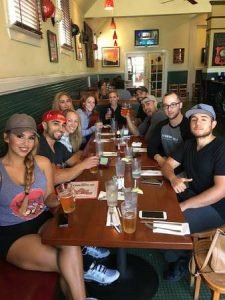“You can’t have a tribe without a leader, and you can’t be a leader without having a tribe.”
“People want to be a part of a movement and yearn for change.”
“People want to be led not managed.”
These are some of our favorite quotes when it comes to building a tribe.
We’ve been coaches for over a decade now. We’ve noticed this trend to just be online and lose all human communication the past five years.
From what we see now, we think things are going to go back to the old days where people want more human communication, more community and to be a part of a movement.
In this article, we will share with you five elements we’ve learned the past decade to help you create a micro movement within coaching.
#1 Stick Your Flag in the Ground and Stand by It
When you are looking to build a community within your coaching business, there has to be a point where you stick your flag in the ground and stand by it. In other words, you need to be unapologetic about what you stand for, your movement, and how you can add value to someone’s life.
We will give you an example of what we do so it can get your wheels spinning:
If someone comes to us for coaching, we are very transparent upfront about what we offer. If this potential client doesn’t want to grow as a person and enhance their overall lifestyle, then we will gladly turn them away and tell them there’s thousands of coaches out there that can get you the fitness results only. This client may be upset at us, but we are unapologetic about what we stand for and provide here within our coaching business.
A good way to stick your flag in the ground and stand by it is to start with a manifesto for your business, community, and culture. Don’t make it too hard or overthink it. Just be transparent about what you stand for as a community and this manifesto will attract the right people to your movement.

#2 You Don’t Need Millions of Followers
It’s funny these days how social media has a lot of people stressed and worried about their following.
When you truly think about it, they’re just numbers on a screen.
Last time we checked, these numbers don’t pay your rent.
Someone can be popular and have a million followers, but does that mean they’re raving fans? Does it mean they want to be a part of that community? Do they want to support the movement?
A better way to look at this is to find your 1,000 true fans. This was popularized by author Kevin Kelly.
We would rather have 1,000 true fans that are highly engaged, raving about our movement, and want more of the community we are building than millions of followers that just “like” our pictures.
Find your 1,000 true fans by starting a private Facebook group, post value driven content on social media, be a giver instead of a taker, hold in person meet ups, and engage with people so they become raving supporters.
#3 Make It Easy for Your Supporters to Follow You
We don’t like using the word ‘fans.’ Last time we checked we don’t have a star with our names on Hollywood Boulevard.
Instead, we like the word ‘supporters.’
Nobody likes to be called a fan.
A big mistake we made when we first started creating a movement was we didn’t make it easy for our supporters to find us and be a part of the community.
We were all over the place with our social media handles. The website didn’t have a clear and concise message about our movement. We were sloppy about engaging with people on social media. You get the point.
Make it easy for your supporters to follow you by:
- Having a monthly or weekly newsletter
- Have a podcast or YouTube channel so they can find your content
- Have a Facebook live show every week so its almost like a TV show they anticipate watching weekly
- Be very consistent with all your social media handles (i.e., FB, YT, IG, Twitter should all have the same name)
- Don’t be lazy about engaging with your community, get back to their comments and messages

#4 Make It Easy for Your Community to Connect with One Another
Make it easy for your supporters to follow you.
This is another big mistake we made when we first started. We didn’t make it easy for our community to connect with one another.
We are human beings at the end of the day, and we crave relationships and human interaction.
Like we mentioned earlier, the whole online coaching model is great and all but not if you don’t make it easy for your community to connect with each other.
You will be looked at like just another online coach or team that hides behind keyboards, has no human communication, and has no movement behind it.
Make it easy for your community to connect with each other by:
- Creating private/exclusive FB groups
- Do team meet ups
- Do group zoom calls
- Create an exclusive members site,
- Create IG/FB messenger/text message group threads
#5 Track Your Progress
We are big advocates of tracking and measuring progress within building a community and movement.
Its very easy and lazy to go about it by just having a mindset of letting it just grow by itself.
Building a community is just like anything else, it takes work. But it doesn’t have to be hard work or full of stress.
We have seen that the more we experiment, track, and measure progress, the more our community will grow and want to be a part of what we are building.
The community and movement doesn’t want to be stagnant. They want it to be dynamic, they want to be heard and have a voice, and they want to evolve with you.
Make it easy to track your progress by:
- Polling your Facebook groups
- Surveying your community using online survey platforms but just be careful with the questions you ask in surveys
- Directly ask community and clients what they want more of, don’t be afraid to hop on the phone with people
- Use a simple spreadsheet to test and measure what you are experimenting with for your community to see if its working or not

Going back to what we said in the beginning of this article, we think things are going to go back to the old days where people want more human communication and to be part of a movement.
These five elements have really helped us grow our community, take a stand for our movement, and it’s given us a lot of gratification to see people connect and grow.
Just realize that money isn’t the point for a movement, money exists to enable it. The moment you cash out it all stops. Have a mindset of building a community and movement that’s bigger than YOU, make it about them and serve them, connect people, and build a thriving tribe around your coaching business.
If you’d like to see how we are creating a micro movement and community, we invite you to join our free and exclusive Facebook Group here.
Chris and Eric Martinez, also known as the “Dynamic Duo” operate a world class Online Fitness, Lifestyle, and Business Consulting Company by the name of “Dynamic Duo Training.” Chris and Eric are also Business coaches that help fitness enthusiasts grow their online businesses. Along with being #1 International Best Selling Authors and Speakers.
Chris and Eric have worked with thousands of people via online and in person to help them look better, feel better, perform better, and live a dynamic lifestyle through training, nutrition, mindset, personal development, and lifestyle practices.
They practice what they preach on a daily basis and that’s to live a dynamic lifestyle, which in their eyes means to keep evolving in life, training, and nutrition, and to never live a static and complacent lifestyle. Be excited every morning and reach for the stars, you deserve it!
Checkout their Podcast show where they interview different experts from around the world on how to enhance your lifestyle through health, wealth, love, and happiness. “The Dynamic Lifestyle Podcast” here https://dynamicduotraining.com/dynamic-lifestyle-podcast/
This is a Contributor Post. Opinions expressed here are opinions of the Contributor. Influencive does not endorse or review brands mentioned; does not and cannot investigate relationships with brands, products, and people mentioned and is up to the Contributor to disclose. Contributors, amongst other accounts and articles may be professional fee-based.

